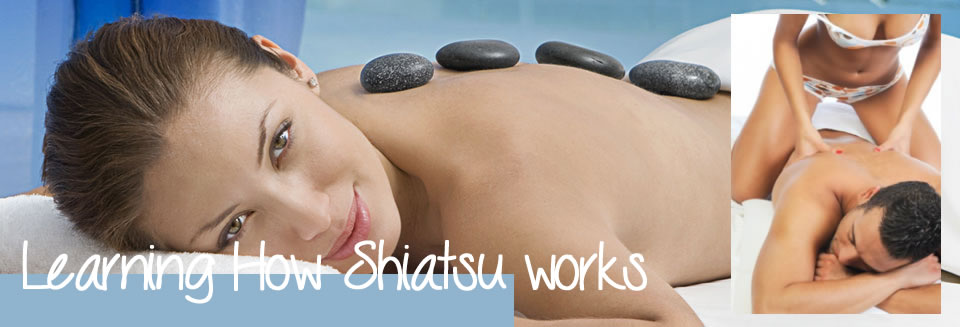Learn Shiatsu
Learning How Shiatsu can work for you
Bring in the new year - Learn Shiatsu's Introduction to shiatsu contains very important pointers that will help you learn the art of Shiatsu effectively; it also presents some important 'do's and don'ts' to consider when giving a Shiatsu treatment.
See commonly asked questions about Yoga
Therefore it is strongly recommended that you read it carefully before proceeding to Part One.
- Yin and Yang
- THE ABDOMEN TREATMENT
- Leg Pressure Points
- Preparing for a Shiatsu Session
- The Five Elements
- Shoulder pressure points
- THE STEP-BY-STEP SEQUENCE
- RESOURCES
- The origins of Shiatsu
- Techniques
- How to find the points
- POINTS TO REMEMBER
- How much pressure to use
- SELF-SHIATSU
- Choosing a school or practitioner
- SELF-TREATMENT
- Shoulders Treatment
- Vital organs
- Energy channels
- TREATING THE INDIVIDUAL
- DEVELOPING YOUR TECHNIQUE
- Energy in the hands
- Hara and breathing
- SELF-DEVELOPMENT EXERCISES
- Back of body treatment
- Front of leg pressure points
- Toe Treatment
- Tsubos
- Kyo and Jitsu
- Increasing your sensitivity
- Governing Vessel
- Forehead Massage

Other sites to look at
| capital-spas.co.uk |
| katyperrybeauty.co.uk |
Tsubos
Points in Shiatsu are known as Tsubos, a Japanese word meaning 'vase'. This is because the impression on pressing on a Tsubo is, first of all, some resistance, which yields as the point is held, whereupon there is a feeling of 'opening out' under the thumb, before connecting with the 'bottom' of the point. This is illustrated in the diagram below; even if you do not experience these perceptions immediately, you will do so if you practise enough, and learn to locate points more precisely. What you are doing, in effect, when pressing and holding a Tsubo in this way, is connecting with the Ki underneath the point's surface, many Tsubos being 'gateways' into a Ki channel or meridian. The way you experience Ki in specific points is known as the Tsubo effect.
One of the main differences between acupressure or acupuncture and Shiatsu, and one of the great benefits of Shiatsu, is that you can actually treat any point on the body, and not just the ones that are on the classical channels. However, the classical points are more obvious to locate, more straightforward to treat, and easier to learn the effects of; so you will probably do best to focus on these at first. Later, you will find that you can apply the same principles in an almost infinite number of locations.
Tsubos
Points in Shiatsu are known as Tsubos, a Japanese word meaning 'vase'. This is because the impression on pressing on a Tsubo is, first of all, some resistance, which yields as the point is held, whereupon there is a feeling of 'opening out' under the thumb, before connecting with the 'bottom' of the point. This is illustrated in the diagram below; even if you do not experience these perceptions immediately, you will do so if you practise enough, and learn to locate points more precisely. What you are doing, in effect, when pressing and holding a Tsubo in this way, is connecting with the Ki underneath the point's surface, many Tsubos being 'gateways' into a Ki channel or meridian. The way you experience Ki in specific points is known as the Tsubo effect.
One of the main differences between acupressure or acupuncture and Shiatsu, and one of the great benefits of Shiatsu, is that you can actually treat any point on the body, and not just the ones that are on the classical channels. However, the classical points are more obvious to locate, more straightforward to treat, and easier to learn the effects of; so you will probably do best to focus on these at first. Later, you will find that you can apply the same principles in an almost infinite number of locations.
Prices and Tuition
£50 for "First Session" Pilates or Pilates/Yoga or Yoga session, 1 1/2 -2 hours (where a consultation is involved). The first Pilates only or mixed Pilates/Yoga session is £50 for 1 1/2 - 2 hours. £30 for 1 hour £45 for 1 1/2 hours (Minimum rate is £45 for 1 1/2 - 2 hours unless it's a regular £30 1 hour session. ) £60 for 2 hours Other options are available, contact us if for other options. One-to-one rate/small group rates (2-4 clients, rate is the total payment, irrespective of number of participants.) Price reductions are negotiable for regular sessions.
